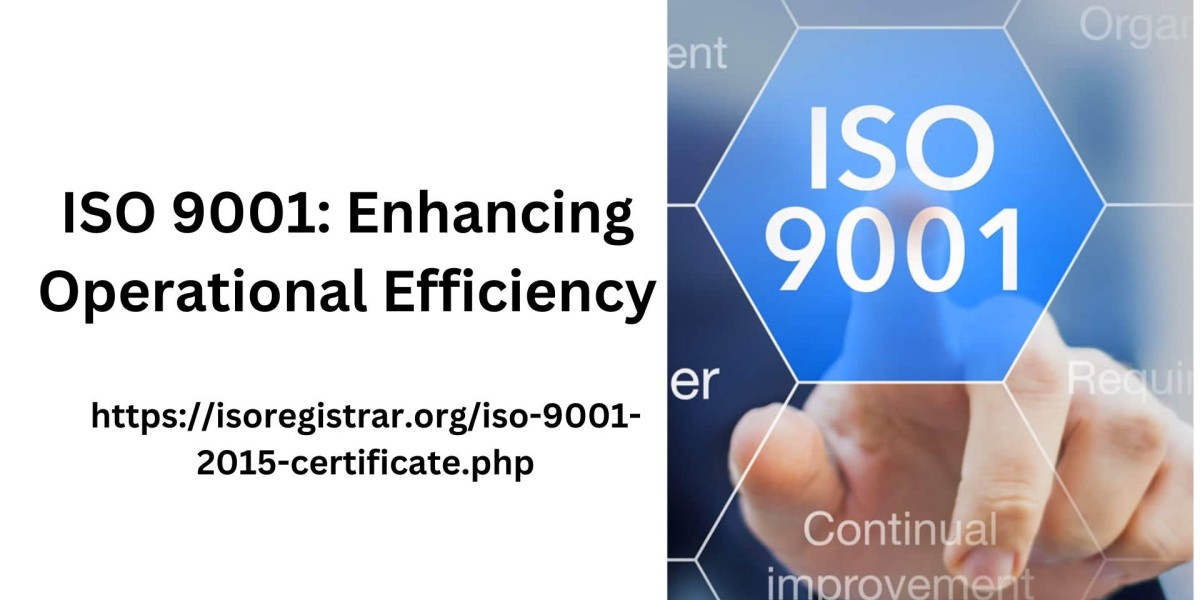Introduction
ISO 9001 certification is an internationally recognized standard for Quality Management Systems (QMS) that provides a framework for organizations to ensure consistent quality in their products and services. One of the significant benefits of ISO 9001 is its role in enhancing operational efficiency. By implementing ISO 9001, organizations can streamline processes, reduce waste, and improve overall performance. This article explores how ISO 9001 enhances operational efficiency through its principles and requirements.
1. Process Optimization
ISO 9001 emphasizes the importance of a process-based approach to quality management. The standard requires organizations to identify, document, and manage their core processes systematically. This approach helps organizations map out their workflows, identify inefficiencies, and optimize their processes for better performance.
By focusing on process optimization, organizations can eliminate redundant steps, reduce cycle times, and enhance the consistency of their operations. For example, standardizing procedures and workflows ensures that tasks are performed consistently, reducing variations and minimizing errors. This results in smoother operations and more predictable outcomes.
2. Improved Resource Management
Effective resource management is a key component of ISO 9001. The standard requires organizations to manage resources, including human resources, infrastructure, and work environment, to ensure that they are used efficiently and effectively.
ISO 9001 helps organizations establish clear roles and responsibilities, ensuring that personnel are adequately trained and equipped to perform their tasks. By aligning resources with organizational needs and objectives, organizations can reduce waste and optimize the use of their assets. This includes managing inventory levels, maintaining equipment, and ensuring that facilities are suitable for their intended purposes.
3. Enhanced Risk Management
ISO 9001 incorporates a risk-based approach to quality management, which involves identifying and managing risks that could impact operational efficiency. By proactively assessing potential risks and implementing mitigation strategies, organizations can prevent disruptions and maintain smooth operations.
The standard requires organizations to identify risks and opportunities related to their processes and implement actions to address them. This proactive approach helps organizations anticipate and address potential issues before they escalate, reducing downtime and ensuring that operations remain efficient and effective.
4. Streamlined Communication and Coordination
Effective communication and coordination are essential for operational efficiency. ISO 9001 promotes structured communication channels and clear documentation, which helps ensure that information flows smoothly throughout the organization.
By establishing clear lines of communication and documenting processes, organizations can reduce misunderstandings, avoid duplication of effort, and ensure that everyone is aligned with the organization's objectives. This streamlined communication helps teams work together more effectively, leading to improved collaboration and more efficient operations.
5. Continuous Improvement
A core principle of ISO 9001 is the commitment to continuous improvement. The standard requires organizations to regularly assess their performance, identify areas for improvement, and implement corrective and preventive actions. This focus on continuous improvement drives operational efficiency by encouraging organizations to constantly seek ways to enhance their processes and performance.
ISO 9001's emphasis on monitoring and measuring performance helps organizations identify inefficiencies and areas for improvement. By analyzing performance data and implementing improvements, organizations can enhance their processes, reduce waste, and achieve higher levels of efficiency.
6. Effective Document and Record Management
ISO 9001 requires organizations to maintain and control documents and records related to their QMS. Effective document management ensures that procedures, work instructions, and other critical information are readily accessible and up-to-date.
By implementing a robust document control system, organizations can ensure that employees have access to accurate and current information, reducing errors and improving the consistency of their operations. Proper record-keeping also facilitates better decision-making and enables organizations to track performance over time, further supporting operational efficiency.
7. Customer Focus and Feedback Integration
ISO 9001 places a strong emphasis on understanding and meeting customer requirements. By focusing on customer needs and incorporating feedback into their processes, organizations can improve the quality of their products and services, leading to increased customer satisfaction.
Integrating customer feedback into operational processes helps organizations identify areas where they can improve efficiency and effectiveness. For example, analyzing customer complaints and feedback can reveal process inefficiencies or areas where improvements are needed. By addressing these issues, organizations can enhance their operations and deliver better value to their customers.
8. Cost Reduction and Waste Minimization
ISO 9001 helps organizations identify and eliminate waste in their operations. By focusing on process optimization and continuous improvement, organizations can reduce unnecessary costs and streamline their operations.
The standard encourages organizations to implement best practices and efficiency measures, such as reducing rework, minimizing defects, and optimizing inventory levels. These cost-saving measures contribute to overall operational efficiency and help organizations achieve better financial performance.
9. Performance Measurement and Monitoring
ISO 9001 requires organizations to measure and monitor their performance to ensure that their QMS is effective and achieving its objectives. By establishing key performance indicators (KPIs) and regularly reviewing performance data, organizations can track their progress and identify areas where improvements are needed.
Effective performance measurement and monitoring help organizations identify trends, assess the effectiveness of their processes, and make data-driven decisions. This approach enables organizations to continuously refine their operations and improve efficiency over time.
10. Enhanced Employee Engagement
ISO 9001 promotes employee involvement and engagement in quality management activities. By involving employees in the development and implementation of processes, organizations can tap into their insights and expertise to enhance operational efficiency.
Engaged employees are more likely to contribute to process improvements, identify inefficiencies, and support the organization's goals. This increased involvement leads to a more motivated and productive workforce, further enhancing operational efficiency.
Note: apply for iso 14001 certification through the iso portal
Conclusion
ISO 9001 certification offers numerous benefits for enhancing operational efficiency. By implementing the standard's principles and requirements, organizations can optimize their processes, improve resource management, and enhance risk management. The standard's focus on communication, continuous improvement, and performance measurement drives better collaboration, reduced waste, and increased efficiency.
Through effective document management, customer feedback integration, and employee engagement, ISO 9001 helps organizations streamline their operations and achieve better performance. By leveraging ISO 9001 to enhance operational efficiency, organizations can not only improve their internal processes but also deliver greater value to their customers and achieve long-term success.



